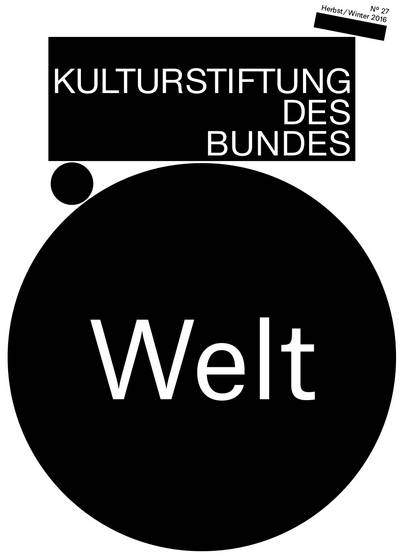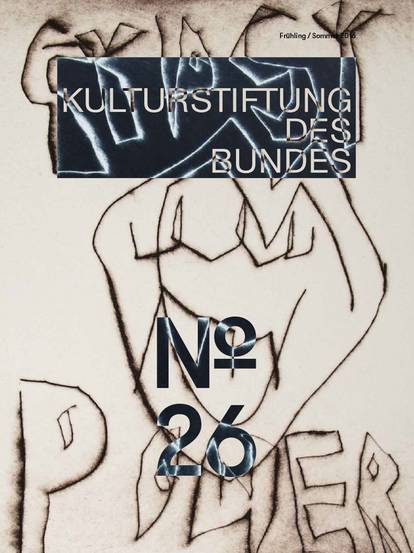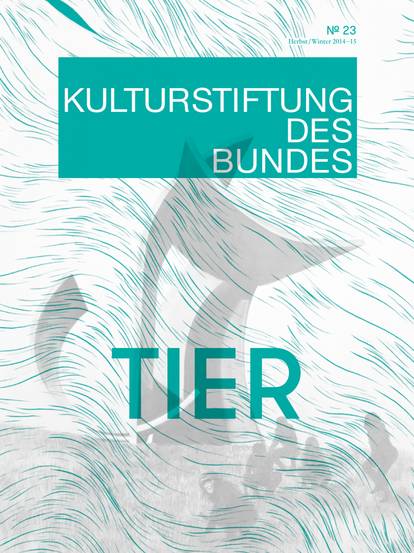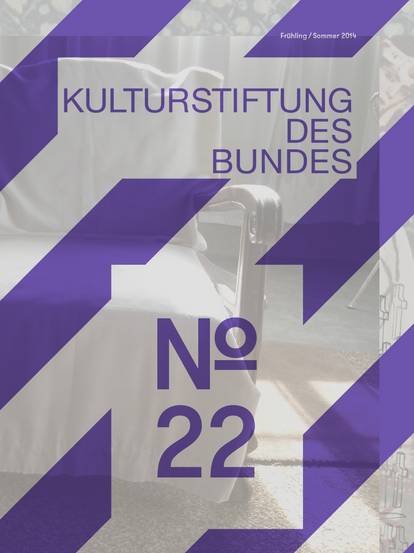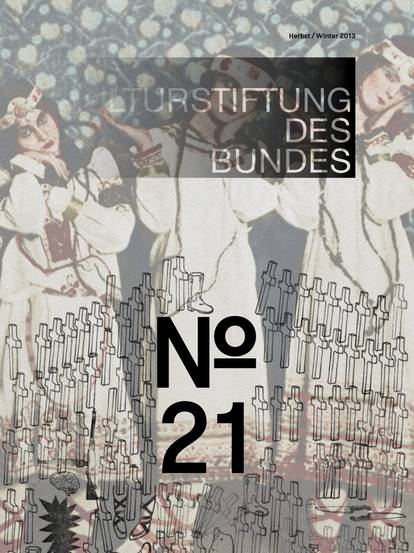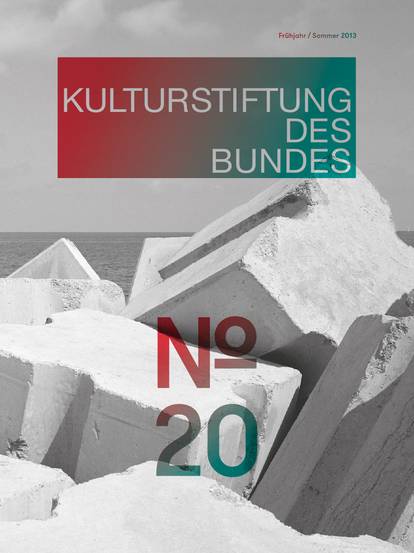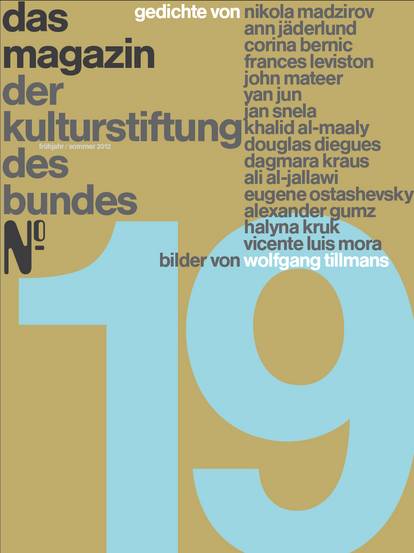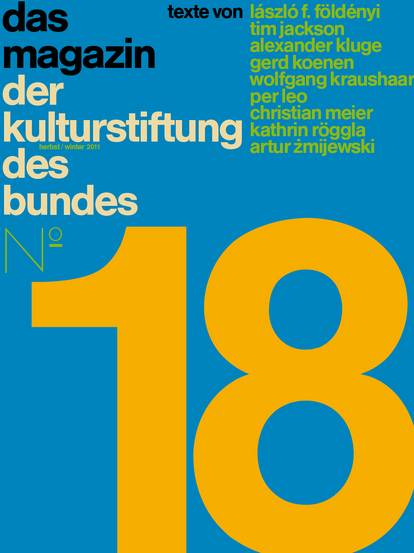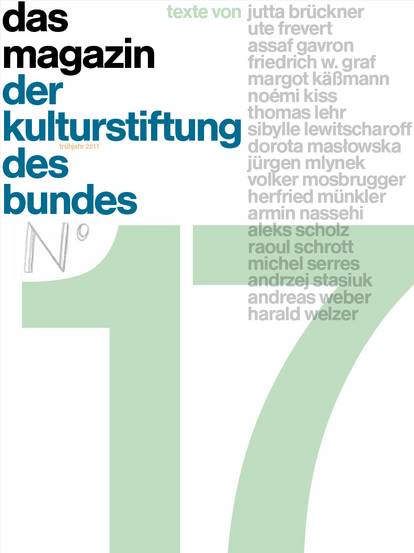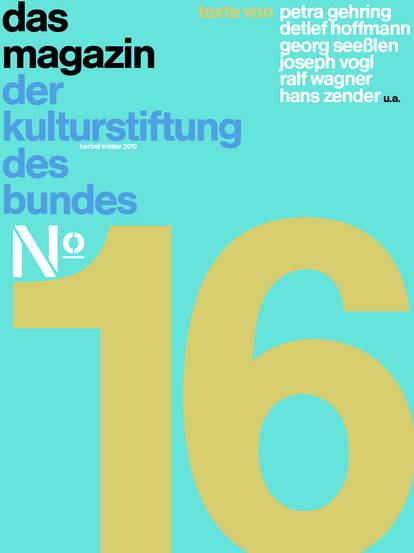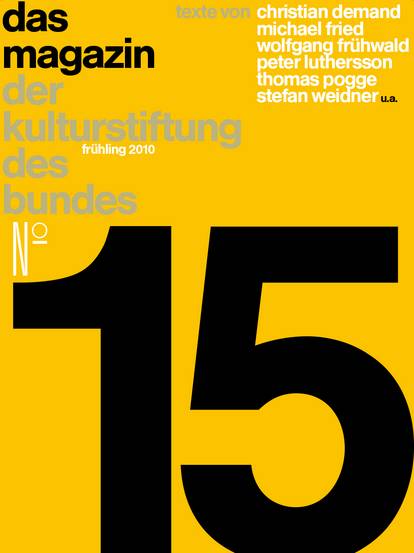What images of the country do we encounter in the media? In its various depictions, we discover that the concept of the country is enlisted to represent a specific epoch – the mythical, the political, the technical and the digital age. In the following, the literary scholar Nils Plath and the filmmaker Robert Bramkamp discuss how we might discover the hidden details of the visible world.
Nils Plath According to the art historian Martin Warnke in his treatise “Political Landscape”, we can recognise the results of political decisions in even the most basic depictions of the country. “The size, order and planting of the fields and the location of the farms are determined by land consolidation, green plans, agricultural subsidies and market controls.” The country is also viewed as something aesthetic. It appeals to urbanites who wish to escape the city; it’s a place where they can find respite and recreational enjoyment outside the urbanised environment.
Robert Bramkamp The agricultural use of the land still defines the country – even when our landscapes are only virtually designed and depicted in video games. As early as the mid-1980s, a process began in rural communities which eventually became the Internet of Things. In the pig sty. The operations were entirely digitalised for the first time. The process was only captured in trade films. It showed the rain communicating with the plant, the plant with the pig and with the contents of a silo. It was the start of a development, the consequences of which we recognise everywhere today and at a faster pace.
NP That was the subject of your film “Gelbe Sorte” (Yellow Variety) which you made between 1985 and 1987. Now it appears the public has gained a new awareness of the country in its various functions ... as an idyll of pastoral longing, as an image of emptiness, as a touristic promise, as a projection for feelings of home ... in other words, as a metaphor for both imagined and imaginative concepts of reality.
RB Nowmight be a good moment to bring certain things together,which hasn’t been possible in recent decades for various reasons. German reunification was a determining element which, thanks to the successful fusion of the TV crime series Tatortand Polizeiruf, was followed by a retro-realism that largely influenced the depiction of the country and its realities in film without offering any alternatives. The second reason would be the first 16 years of digitalisation by a handful of global companies. The reason being that rurality changed during these years; it became an alternative to video games and virtual reality – and now represents a complementary scenario. Understanding this transformation of the country over time and in time is something I find extremely fascinating.
NP It’s about assessing personal and collective perceptions of time against the background of these developments and changing aesthetics. In his film Reichsautobahn, Hartmut Bitomsky showed how building a network of interstate highways was meant to aestheticise the country and introduce perspectives to the landscapes which influence our views to this day.
RB Today the cars continue to snake their way along the autobahn like the mythical creature Friedrich Kittler described as the first manifestation of a 20th-century deity: an endless convoy of military vehicles with red taillights around the time of World War I which snaked westward across the countryside, and,like a snake, revealed the structures of the country through the contours of road construction. Today we could imagine the ICE trains winding through the country. It points to fact that in the country, land consolidation and agrarian cultivation influences our perception, and at the same time, that certain mythical deities are still present. The serpentine queue of cars on the autobahn would be one such deity.
NP The same applies to different ages – the age of technologised modernism and the age of legend – both simultaneously imprinted into the countryside. You just need to know how to recognise them to avoid a flat reflection of realism when gazing upon the country and the landscape.
RB Exactly. With regard to filmmaking, double exposures are especially critical when it comes to such recognition. These are cinematic images which could equally belong to very different periods. Surprisingly it seems that the Berlin school has now arrived at the same conclusion, for example, in Christian Petzold’s current film Transit as I watch the ship leave Marseille – in present time. Here’s an image that belongs to the present, but simultaneously belongs to the past or a parallel sphere. I was delighted to see that. For I believe this effect of double exposure is crucial for viewing contemporary landscape as a cultural development project. It creates new space for other perspectives and divergent views of the country, for its mythicisation, but also its de-mythicisation. Like in Aron Sekelj’s current film Landschaften des Krieges, Landschaften des Friedens (Landscapes of War, Landscapes of Peace), a documentary of the battlefields in Serbia. It shows excerpts of landscapes from media reports on the Balkan War with all the military equipment cut out. The images evoke the question of what extent land is depicted historically – and medially. At the same time, the film is an exercise in mourning in that it tries to get the landscape itself to speak ... as one of the double exposures.
NP As a multifaceted search for clues, and as a lesson in local history ... Like you, growing up in Münster, I remember my father and I taking walks through the farming community in the Westphalian countryside, and how he explained what the tank symbols on the bridge signs meant: they indicated the load capacity of the bridges over which the tanks could cross. That was back in the time of the Cold War in the 1970s. The starfighters would practice landing on the unfinished bypass highways. The country was a place for children’s games, the rural outskirts of our rebuilt downtowns – and at the same time I learned that our region was a possible theatre of war and was preparing to become one. This was the subject of an impressive and one of most influential German landscape films of the 1980s, Rüdiger Neumann’s Meridian oder das Theater vor dem Regen (Meridian or the Theatre Before the Rain). This simultaneity of different times that allows us to experience the permanent change and perpetual incompleteness that affects the country differently than the city – this is an experience we can save. For later.
RB It’s something that current views of the country might allow us to experience again.
NP In his volume of texts Amorbach, published in the Süddeutsche Zeitung in 1966, Theodor W. Adorno described the town of the same name in the Franconian Odenwald where he had spent the summers of his childhood and had returned many times after his exile, as a place like no other in his childhood. As a town nestled in the countryside where differences were visible. For him, Amorbach was a place that offered him something, the “experience of happiness”, as he calls it, “of the irreplaceable, albeit in hindsight, it was not unique.” Even though, as he admits, it didn’t succumb to standardisation and normative pressure.
It seems to me that he’s describing a residuum which has become even more significant today. The place in the country preserves the remains of childhood experience and perceptions and reactivates them years later – as something that weatherproofs the present against a lack of diversity. Holding on to memories of the country also possesses the potential of resistance – or the danger of embracing a regressive ideal as a self-stylised autochthon and refusing to let it go. That seems to apply to the current situation, also with respect to the land acquisition and development in former East Germany.
RB Adorno is obviously describing a place that he knows is fictitious. One can imagine it exists and – to a certain extent – deny the danger it faces. Because this denial holds the potential for resistance. That’s the best method of resistance which also has a certain staying power. For example, resisting digitalisation as we’ve experienced it these past sixteen years – as colonisation. The places in the country continue to be real nonetheless. As necessary as postcolonial commitment might be, according to Martin Burckhardt in his book Alles und Nichts. Ein Pandämonium digitaler Weltvernichtung (All and Nothing. A Pandemonium of Digital Global Destruction), it’s equally important to think about the precolonial situation. Because we ourselves are becoming digitally colonialised. With all that the word implies: we are losing our freedom. This colonialisation is overwriting the country and increasingly turning it into a digital space. Yet the country ideally embodies our analogue reserve.
NP We would have to present the boundary between the digital and analogue more clearly as an asset. Especially in light of the fact that sustainability primarily refers to long-term storage and presentation on the Internet.
RB Agrarian monoculture has already done away with numerous classificatory criteria. This has become exponentialised through digitalisation. Yet order of classification is enormously important because it creates a space for the active figures in the country. If boundaries no longer exist which a mobile figure can cross, it has repercussions for the individual and the collective. The restrictiveness of their environment renders them completely static. Therefore, they embrace the suggestion of a complementary environment to which they can travel far away and record their experiences in other locations and in other spectacular landscapes using their GoPro. And all this so that they can reimagine this decisive boundary which enables them to appear in motion.
NP In his acceptance speech for the Fontane Prize in 1979, Alexander Kluge spoke of an antirealism of emotions, a denial of the pure reality principle which allows us to direct our attention beyond ideology. Notably he illustrates this with reference to the foot of land which Hölderlin describes differently than what is found in the biology book or statistics. And he differentiates between one’s immediate sense of nearness and of distance. Children form a sense of nearness in that they presume the world is locally organised by real people. Yet decisions are not made in our immediate, perceivable vicinity. Distant places, places we cannot directly experience, are where truly significant things happen. Kluge claims that neither come together. If we go out into the country today and take this intensity of everyday emotions seriously which resists this dialectic and which Kluge hopes to politically strengthen, then what is there to see or experience with respect to the country?
RB It’s about not repeating the same questions and answers which we always project upon the poor landscape. In the case of the former GDR, these are questions like: “It looks just like it used to back in the GDR, will things ever change?”, “How does it feel to live where the bus ride to school never ends?” “What progress has been made since reunification?” No matter where I position the camera, as a filmmaker I’ve discovered that the answers to these questions were obvious. The landscapes were barraged with the same questions over and over, those standard questions posed in TV documentaries and films. Now we realise that the media space for other perspectives has vanished.
NP Can we ever get it back?
RB It can only come back when we realise that it won’t come back by itself; it must be remade. And that primarily by moving against the image of the times. We have to instil the country with narratives in a special way. Otherwise this will be done solely by social media channels.
NP Which means creating time-based narration in which the present and past are placed in a causal relationship.
RB To portray the demise of farms in the Münsterland, but not in a sentimental or clichéd way – that’s what I was aiming for in Gelbe Sorte. I told myself that we just had to keep shifting the banal failure chronologically and geographically until it became volatile in a new context. In other films, what they show is the country, prejudice and sentiment combining as a paradise. But this paradise is in danger. That’s the formula many TV movies still follow in their portrayal of the country. The alternative portrayal is one that reveals that the demise of a Münsterland farm in the pork cycle which is still active today and has transformed all of northern Germany into a corn field where bees or classificatory boundaries no longer exist – is actually not banal at all. Our only recourse is to focus on the far-reaching developments which continue unabated today and have grave consequences for us all – environmentally and culturally. It’s about showing that significant visible aspects of this issue are indeed being steered by invisible forces – that behind every hedge there lies an Excel table or a computer programme that calculates the price of diesel with relation to the stock prices of BASF which in turn influences the price of artificial fertiliser. ... It’s like a second matrix, a closed system, which underlies the visible countryside. To react to this using the possibilities of cinema – namely, to observe it more closely, run through the scenarios and honestly present the emotions – we had to add something that normally isn’t there. With an absolute desire to connect.
NP In Peter Kurzeck’s magnificent bookVorabend (Before Evening Falls), he contrasts cosmopolitan life with the memory of changing village life of his childhood, based on the motto “Describe the entire area, the time!”
RB If you consciously insert such layers, possibilities and dual interpretations into film nowadays without devolving into self-imposed kitsch or forced participation, you discover that dialects, collective accents and visual dialects always possess a specific and limited potential for connection. Like the industrial film in Gelbe Sorte or the Chinese propaganda films. Through these gaps, one can sense the “paper-tiger character” of reality, as Kluge called it. That would be the opposite of immersion. Immersion means plunging yourself into the whole. And it’s becoming increasingly prevalent today. It ties into a technological addiction which opposes the sense of nearness in the country every day. The “beautiful” things that travel catalogues and country life praise don’t lead to practices which combine the sense of nearness with a desire for connection. They only function in a certain idyll which is consumeristically reanimated in connection to fantasies of wholeness.
NP Michael Rutschky once observed that just outside the city, urbanites are renewing the image of themselves and their urbanity in the country. Meanwhile, the DIY stores are outfitting the rural population. The ability to differentiate between them at the local level is slowly dwindling.
RB The fewer people out in the fields, the more they’re out shopping at DIY stores and shaping the land. And this limits our creative possibilities to the extreme. Heinz Emigholz would say that we live in a ramshackle house – in a roughshod environment. The DIY stores have created a fictitious counter-realism. We have long wished to be different and express our individualism, and now everything looks the same. Judging from the appearance of the country, we realise that collectivism isn’t possible within the given classificatory boundaries and beyond proprietary niches. These can serve as the basis for bad stories. Or at best, quirky neighbourhood stories. But even these overwrite the DIY store reality. The collectivisation of experience is hardly possible. Which is why I feel so fortunate we – Susanne Weirich and I – were able to experience it while working on the film Der Bootgott vom Seesportclub and the joint narrative project Die 100 Me in Wendisch-Rietz near Berlin. In both projects we attempted to temporarily achieve something collective by draping a narrative layer – 100 divine abilities from the Sumerian Enki legend – over the entire area. Local residents were involved and played various roles. As we did ourselves, so that we’d come across as credible protagonists. But the sustainability of this collective spirit quickly ceased as soon as we left the area.
NP Sustainability requires enormous efforts which run counter to what many people look for in the country: idyllic property or investment opportunities in prospective farmland, investor models or agricultural-industrial facilities.
RB Rural space has indeed become an asset for fictitiously produced money. There is little interest in developing something worthwhile or promoting a cultural text. We would have to fundamentally change direction and say that various culture-building practices are connected to the economic-agricultural use of the land and shouldn’t be reduced to their local recreational value. Rather they need to focus on regional development with the integration of digitalisation and special consideration of the analogue reserves, the local population...
NP ... in order to create a collective narrative.
RB Taking into account the wide range of pictorial dialects, even the DIY store aesthetics. As a counter-image to a monoculture. That would be a way to promote a cultural text which begins in the country and which could be locally developed based on local traditions. We should work to promote expanded regional landscape policies which start with image production.
NP Perhaps in the same way Alexander Kluge contributed to the rise of commercial television, we should develop and offer cultural content for augmented reality services which not only deliver potential returns and advertising possibilities. Rather in the sense of allowing for double exposures of other perspectives and modulating realities.
RB This, in turn, could serve to pressure the public broadcasters to create online services which produce such material – and allow the users to produce it as well. At the same time, the complete library of archived material would have to be integrated into their services. In order to activate the entire digital sensorium which elicits emotions – with historical awareness.
NPIt would then be interesting if these services reached users in their personal algorithm-based echo chambers and presented them with surprising links that not merely confirmed what they already believe or auto-suggested their search queries. That would be a promising new form of local history with a future potential.
Nils Plath is a literary scholar at the department of General and Comparative Literary Studies of the University of Erfurt. He lives and works in Berlin. He has published numerous articles and books on such subjects as documentary film and realism, imagery and writing, pop and contemporary art, and landscape depictions in literature and images. His latest book published by the Kadmos Kulturverlag Berlin in 2017 is titled Hier und anderswo. Zum Stellenlesen bei Franz Kafka, Samuel Beckett, Theodor W. Adorno und Jacques Derrida (“Here and Elsewhere. Interpreting Franz Kafka, Samuel Beckett, Theodor W. Adorno and Jacques Derrida”).
Robert Bramkamp is a filmmaker who, since 1983, has been making narrative films that combine fact and fiction into new perspectives.These include the experimental agricultural film Gelbe Sorte(“Yellow Variety”, 1987), Raketenstudie Prüfstand 7 (“Rocket Study Testing Facility 7”, 2000) and the collaborative film-political piece Dazu den Satan zwingen (“Then We Triumph over Satan”, 2017). He taught film directing at the HFF Konrad Wolf Film University and has been a professor of experimental film at the HFBK Hamburg since 2008.

![[Translate to English:] Magazine 38](/fileadmin/_processed_/f/1/csm_Magazin38_Cover-Vorschau_921x1230_689f428dc3.jpg)
![[Translate to English:] Magazine 37](/fileadmin/_processed_/b/c/csm_Mag37_Cover-Vorschau_921x1230_b5129fdb2a.jpg)
![[Translate to English:] Magazine 36](/fileadmin/_processed_/2/a/csm_Cover_Magazin36__issuu_2f3cef97bb.jpg)

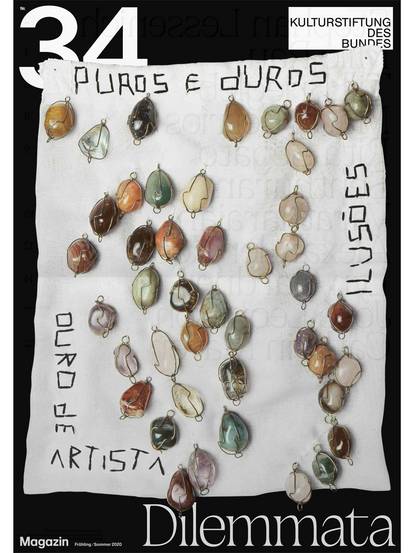
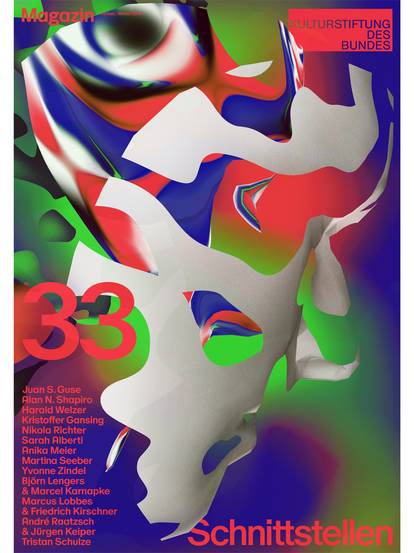
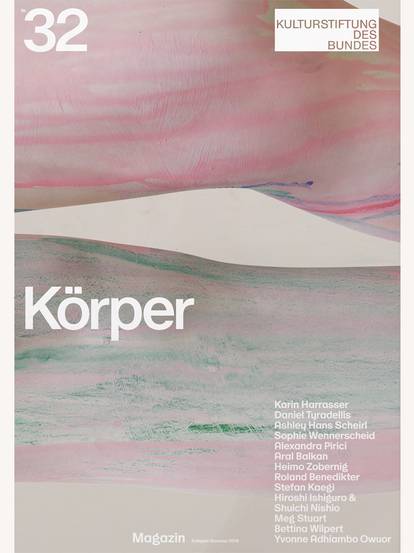
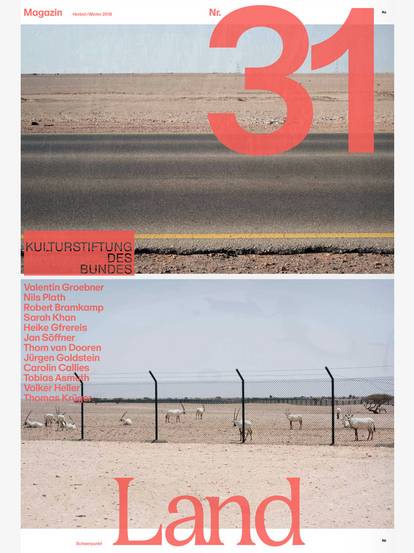
![[Translate to English:] Magazine 30](/fileadmin/_processed_/c/b/csm_magazin30_vorschau_9005f773d3.jpg)


